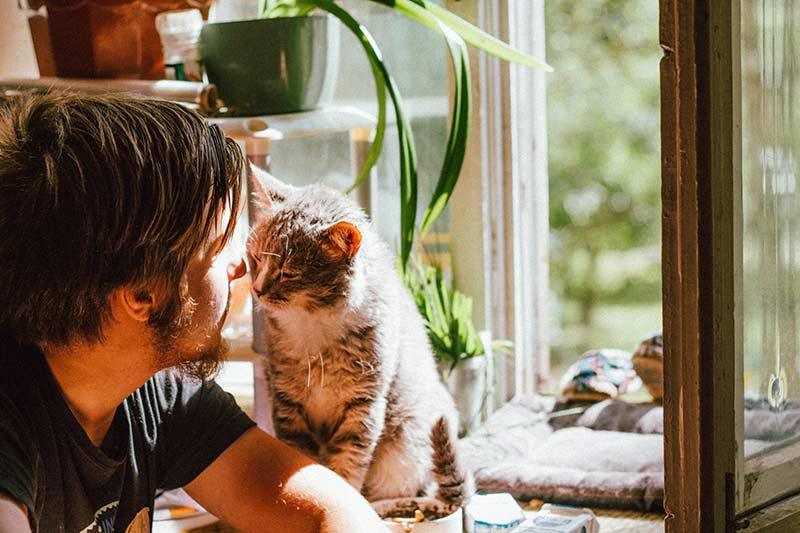9 Ways to Be a Sustainable Cat Parent

Cats might be beloved members of the family and household, but their care can also have a significant impact on the environment. As a responsible cat parent, it's important to consider what steps you can take to reduce the environmental impact of caring for our feline friends.
Here are 9 ways to be a sustainable cat parent:
1. Choose sustainable cat food
When choosing food for your cat, stick with options that are made with sustainably-sourced ingredients. Avoid brands that use nasties like soy or palm oil, the production of which is often associated with environmental destruction, such as deforestation. Additionally, look for products that feature eco-friendly packaging, such as recycled materials or biodegradable containers.
2. Use sustainable cat litter
Traditional clay-based cat litter is not biodegradable, ending up in landfills and taking years to decompose. Fortunately, these days there is an increasingly wide range of eco-friendly cat litter alternatives to choose from, such as biodegradable litter made from materials like recycled paper. Believe it or not, some cat parents even opt for a litter-free approach by training their cats to use the toilet - but we'll leave that decision to you!
Popular litter alternatives include:
- Biodegradable litter - made from materials like recycled paper, wood pellets, or corn, biodegradable litter is designed to break down naturally over time and is often compostable.
- Crystal litter - this litter is made from silica gel, a highly absorbent material that is excellent at controlling odours. A little also goes a long way, making it a more cost-effective option, too. It's important to note, however, that not all crystal litters are biodegradable, so double-check this before you buy.
- Natural litter - made from materials like wheat, corn, and pine, natural cat litter is both biodegradable and compostable. It can, however, be more expensive and isn't always as effective at controlling odours.
3. Choose eco-friendly cat toys
Many cat toys are made from nonbiodegradable plastics, which are notoriously harmful to the environment. Instead, look for pet toys made using sustainable materials, such as recycled plastic or organic cotton.
Failing that, it actually doesn't take much imagination to make your own cat toys from household items like cardboard boxes or paper bags - so long as there's something to chase, climb, paw at, or burrow into, they'll be happy.
4. Use eco-friendly grooming products
When it comes to cat grooming, opt for products that are made from sustainable materials and free of any harsh and harmful chemicals. Sticking to shampoos and conditioners that are made from natural ingredients will be better for kitty anyway, and there are plenty of brushes on the market that are made from eco-friendly materials.
Ensure that you also use reusable washcloths and towels over single-use, disposable wipes, and paper towels.
5. Reduce waste
Cats can create a significant amount of waste, and it's important to dispose of it in an eco-friendly way. Consider using compostable cat-waste bags, which can be added to your compost bin along with other biodegradable materials or composted separately.
6. Reduce energy consumption
Cats might not use up much in the way of electricity, but still, consider whether toys, lights, smart devices, or anything else related to your cat's care needs to be on all the time.
7. Choose sustainable cat furniture
When choosing furniture for your cat, opt for eco-friendly options made from sustainable materials like bamboo or recycled plastic. You can also repurpose items from around your home, such as cardboard boxes, to create fun and functional play areas they can enjoy for hours.
8. Invest in high-quality, durable products
Investing in high-quality, durable products for your cat can help reduce waste and save money in the long run. While it's important to shop for sustainably-made items, it also makes sense to consider the longevity of whatever it is you're buying, and stick to items that are built to last.
9. Recycle and compost
Make sure to properly dispose of cat food cans, litter bags, and other waste by recycling or composting wherever possible. It's also a good idea to check with your local recycling and composting facilities to ensure that you are following the proper guidelines to maximize the impact of your efforts.
Also, be sure to donate any cat toys or other products that are still in good condition once you are finished with them. You can drop them off at your local charity shop or advertise them free to another cat home online.
Final thoughts
With a little extra thought, it can be easy to up your sustainability game as a cat parent and reduce your household's environmental impact. Remember that every small step counts, and by making these changes in your own home, you can inspire others to do the same.